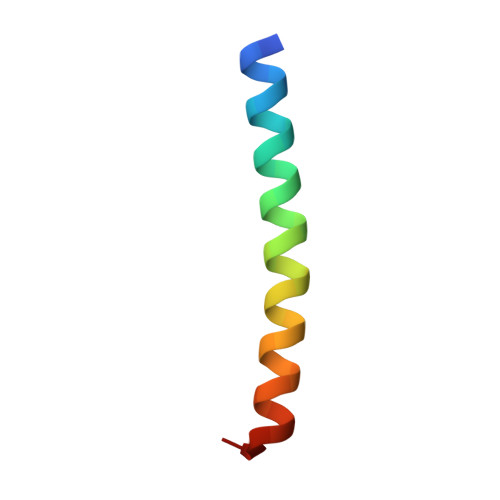Molecular basis of coiled-coil oligomerization-state specificity
Ciani, B., Bjelic, S., Honnappa, S., Jawhari, H., Jaussi, R., Payapilly, A., Jowitt, T., Steinmetz, M.O., Kammerer, R.A.(2010) Proc Natl Acad Sci U S A 107: 19850-19855
- PubMed: 21045134
- DOI: https://doi.org/10.1073/pnas.1008502107
- Primary Citation of Related Structures:
2O7H, 3GJP - PubMed Abstract:
Coiled coils are extensively and successfully used nowadays to rationally design multistranded structures for applications, including basic research, biotechnology, nanotechnology, materials science, and medicine. The wide range of applications as well as the important functions these structures play in almost all biological processes highlight the need for a detailed understanding of the factors that control coiled-coil folding and oligomerization. Here, we address the important and unresolved question why the presence of particular oligomerization-state determinants within a coiled coil does frequently not correlate with its topology. We found an unexpected, general link between coiled-coil oligomerization-state specificity and trigger sequences, elements that are indispensable for coiled-coil formation. By using the archetype coiled-coil domain of the yeast transcriptional activator GCN4 as a model system, we show that well-established trimer-specific oligomerization-state determinants switch the peptide's topology from a dimer to a trimer only when inserted into the trigger sequence. We successfully confirmed our results in two other, unrelated coiled-coil dimers, ATF1 and cortexillin-1. We furthermore show that multiple topology determinants can coexist in the same trigger sequence, revealing a delicate balance of the resulting oligomerization state by position-dependent forces. Our experimental results should significantly improve the prediction of the oligomerization state of coiled coils. They therefore should have major implications for the rational design of coiled coils and consequently many applications using these popular oligomerization domains.
Organizational Affiliation:
Wellcome Trust Centre for Cell-Matrix Research, Faculty of Life Sciences, University of Manchester, Manchester M13 9PT, United Kingdom.














